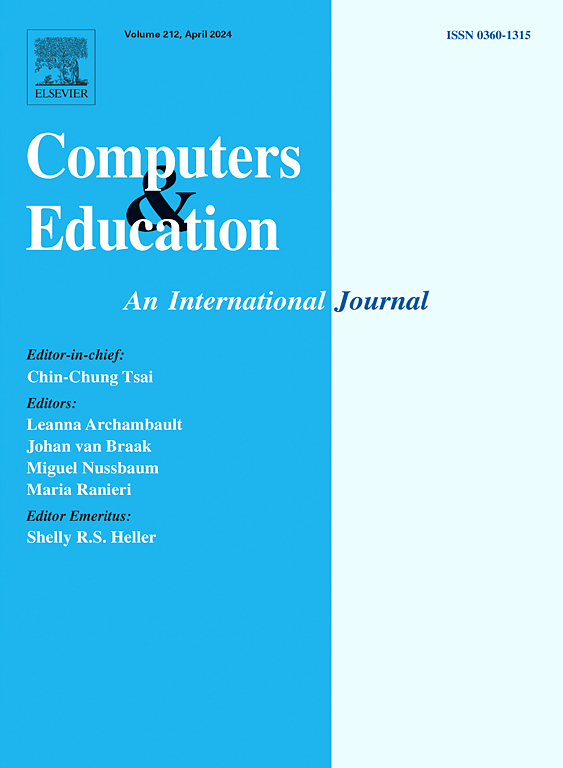儿童在教育空间中使用数字技术:范围审查
IF 10.5
1区 教育学
Q1 COMPUTER SCIENCE, INTERDISCIPLINARY APPLICATIONS
引用次数: 0
摘要
随着教育空间整合了数字体验,儿童参与游戏和学习变得越来越复杂。虽然粘性通常被视为一个多层面的结构,但对于“粘性”一词的含义,通常没有明确且普遍接受的定义或理解。这一范围审查综合了幼儿在教育空间的数字体验中参与的概念化方式。对七个数据库的系统搜索捕获了2011年至2024年9月期间发表的研究。包括在正式或半正式教育环境中进行的报告儿童参与数字技术(例如,通过任何数字体验进行游戏或学习)的研究。总共筛选了2661份记录,纳入了88项研究。18项研究(19.3%)明确定义了敬业度的概念,8项研究(9.1%)将其理论化,31项研究(35.2%)对其进行了测量。参与的理论基础来自数字和教育学科,主要植根于动机理论。专题分析显示了参与的多层面性质,通过从所提供的定义和措施中得出的十个关键主题进行综合。定义中确定的最突出的主题是参与(n = 8, 44.4%),努力(n = 7, 38.9%)以及人际交往技巧和行为(n = 6, 33.3%),而在参与措施中发现的主题主要与享受(n = 14, 45.2%),参与(n = 11, 35.5%)和兴趣(n = 8, 25.8%)相关。本次审查强调了在定义和衡量儿童数字参与方面需要更一致的方法。本文章由计算机程序翻译,如有差异,请以英文原文为准。
Children's engagement with digital technology in educational spaces: A scoping review
Children's engagement in play and learning is becoming increasingly complex as educational spaces integrate digital experiences. While engagement is often seen as a multifaceted construct, there is often no clear and generally accepted definition or understanding of what is meant when the term ‘engagement’ is used. This scoping review synthesised the ways in which engagement has been conceptualised within young children's digital experiences in educational spaces. A systematic search of seven databases captured studies published between 2011 and September 2024. Studies reporting children's engagement with digital technology (e.g., in play or learning via any digital experience) that were conducted in a formal or semi-formal educational setting were included. A total of 2661 records were screened, resulting in the inclusion of 88 studies. The concept of engagement was explicitly defined in 18 studies (19.3 %), theorised in 8 studies (9.1 %), and measured in 31 studies (35.2 %). Theoretical foundations of engagement drew from digital and educational disciplines, primarily rooted in motivational theories. Thematic analysis demonstrated the multidimensional nature of engagement, synthesised through ten key themes drawn from the definitions and measures provided. The most prominent themes identified in definitions were participation (n = 8, 44.4 %), effort (n = 7, 38.9 %) and interpersonal skills and behaviour (n = 6, 33.3 %), while those found in measures of engagement were predominantly associated with enjoyment (n = 14, 45.2 %), participation (n = 11, 35.5 %), and interest (n = 8, 25.8 %). This review highlights the need for more consistent approaches in defining and measuring children's digital engagement.
求助全文
通过发布文献求助,成功后即可免费获取论文全文。
去求助
来源期刊

Computers & Education
工程技术-计算机:跨学科应用
CiteScore
27.10
自引率
5.80%
发文量
204
审稿时长
42 days
期刊介绍:
Computers & Education seeks to advance understanding of how digital technology can improve education by publishing high-quality research that expands both theory and practice. The journal welcomes research papers exploring the pedagogical applications of digital technology, with a focus broad enough to appeal to the wider education community.
 求助内容:
求助内容: 应助结果提醒方式:
应助结果提醒方式:


